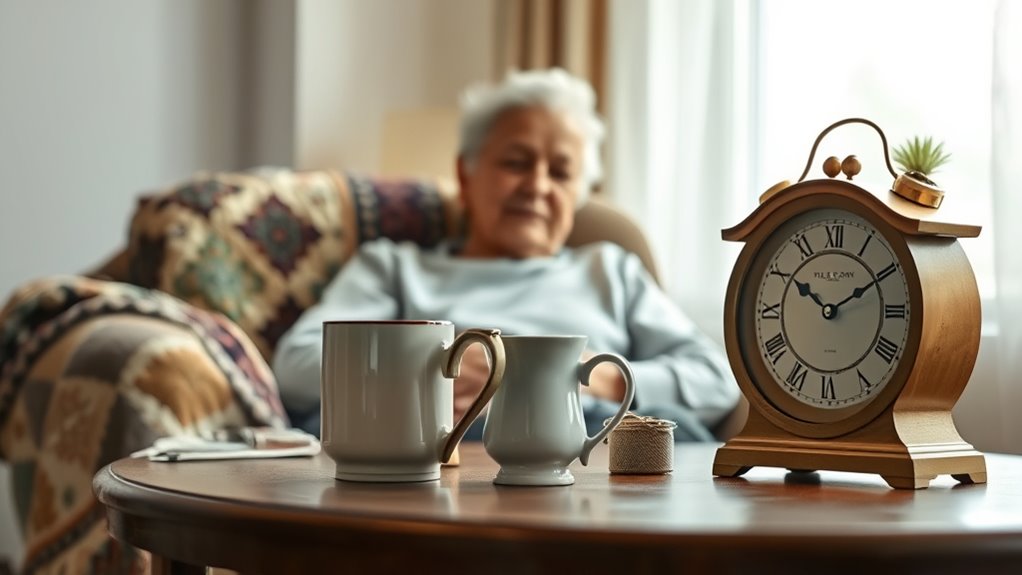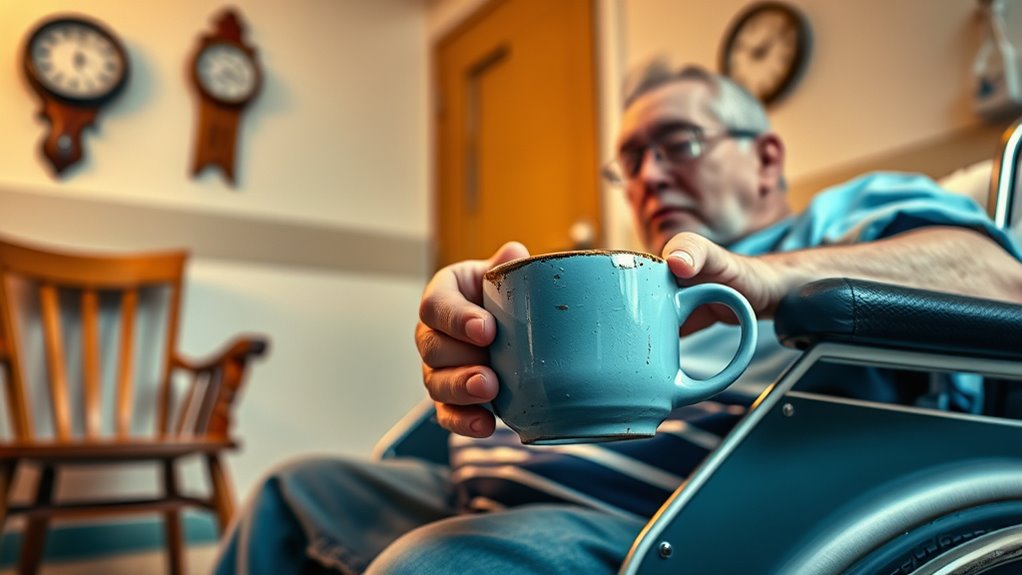Using familiar objects can help ground disoriented patients by providing comfort, stability, and emotional connection. Carefully select personal items that evoke positive memories and integrate them into routines and environments consistently. Keep objects safe, clean, and within easy reach, and observe individual responses to personalize approaches. Establishing familiarity can reduce anxiety and build trust. If you want practical tips for selecting, integrating, and safely managing these objects, you’ll find helpful insights to enhance patient comfort.
Key Takeaways
- Select familiar, meaningful objects like photos or personal items to evoke positive memories and foster trust.
- Integrate familiar objects into routines and environment, placing them consistently to reinforce recognition and stability.
- Use familiar objects to provide emotional comfort, reducing anxiety and promoting a sense of security.
- Ensure objects are safe, clean, and appropriate, supervising interactions to prevent confusion or injury.
- Tailor object choices and placement based on individual responses, cultural background, and environmental factors.
Selecting Appropriate Familiar Items for Grounding

Choosing the right familiar items is essential for effective grounding with disoriented patients. You want objects that evoke positive memories or a sense of comfort, so they help anchor the patient’s awareness. Consider items with personal significance, like a family photo, a favorite piece of jewelry, or a familiar keepsake. Choose objects that are safe, easy to handle, and non-threatening. Avoid items that could cause harm or confusion, such as sharp or fragile objects. Think about the patient’s history and preferences—what they loved or found soothing. Keep in mind that simplicity often works best; overly complex or unfamiliar objects might overwhelm or distract them. Selecting thoughtful, meaningful objects can foster trust and provide a tangible connection to reality.
Techniques for Integrating Objects Into Care Routines

Incorporating familiar objects into daily care routines requires intentional strategies to guarantee they serve their grounding purpose effectively. Start by designating specific objects for certain times or tasks, helping patients associate items with routines. Integrate objects seamlessly, placing them within easy reach during activities like dressing or feeding. Use consistent placement to reinforce familiarity and reduce confusion. To optimize integration, consider this approach:
| Step | Action | Purpose |
|---|---|---|
| Select & prepare | Choose familiar objects relevant to routines | Enhance recognition |
| Consistent placement | Keep objects in the same locations daily | Build routine familiarity |
| Active engagement | Involve patients in handling objects | Promote connection and comfort |
| Educate caregivers | Train caregivers on the importance of consistency | Reinforce routine stability |
Engaging neural pathways through repetition and familiarity can strengthen patients’ ability to recognize and respond to objects, thereby reducing disorientation and supporting cognitive stability. Additionally, incorporating Volkswagen tuning techniques or other familiar modifications can serve as a metaphorical reinforcement for consistency and routine in care practices. Recognizing the importance of cognitive engagement is essential in creating effective grounding strategies.
The Psychological Benefits of Familiar Objects

Familiar objects can considerably reduce your patients’ anxiety and fear by providing a sense of stability. They also offer emotional comfort, helping patients feel more at ease in unfamiliar or confusing environments. By reinforcing a sense of security, these objects support mental well-being during challenging times.
Eases Anxiety and Fear
When patients feel disoriented, familiar objects can serve as powerful anchors that reduce their anxiety and fear. Holding onto something recognizable provides reassurance and a sense of control. This connection to the familiar shifts focus away from confusion, calming the mind. Introducing comforting objects like a favorite blanket or a family photo can make a significant difference. Here’s how familiar objects support this:
| Object Type | Effect on Anxiety | Example |
|---|---|---|
| Personal Items | Foster safety and trust | Jewelry, watch |
| Sensory Stimuli | Soothe agitation | Soft fabric |
| Visual Cues | Reconnect memories | Photo albums |
| Tactile Objects | Grounding in reality | Fidget toys |
| Familiar Scents | Reduce distress | Aromatherapy |
These objects act as reassuring anchors, easing fear and helping patients regain composure.
Promotes Emotional Comfort
Using familiar objects can substantially boost a patient’s emotional well-being by providing a sense of stability and reassurance. When you offer a comforting item from their past, it creates a tangible connection to positive memories and familiar routines. This familiarity can reduce feelings of confusion or distress, fostering a calmer state of mind. As a result, patients often experience increased feelings of safety and emotional warmth. The simple act of holding or seeing a cherished object helps them feel cared for and understood, even during disorienting moments. This emotional comfort can markedly improve their mood and overall outlook, making them more receptive to care and interaction. By incorporating familiar objects, you help create an environment that nurtures their emotional resilience and sense of belonging.
Reinforces Sense of Security
Having a familiar object nearby can substantially reinforce a disoriented patient’s sense of security, providing a reliable anchor amid confusion. When they see or hold something familiar, it helps them feel grounded and connected to a sense of stability. This simple act can reduce feelings of fear and helplessness, making the environment less overwhelming. The familiarity acts as a emotional lifeline, reminding them they’re not alone and that safety exists within reach.
- Feelings of vulnerability diminish, helping them relax
- Anxiety lessens as they recognize a comforting object
- Confidence gradually returns as they regain control
Practical Tips for Introducing and Maintaining Consistency

To help disoriented patients feel secure, you should use familiar objects consistently and integrate them into daily routines. Establishing predictable patterns makes it easier for patients to recognize and rely on these items. Keep these practices steady to reinforce their grounding effect over time.
Subheading 1: Use Familiar Objects Regularly
Introducing familiar objects into a patient’s environment can considerably reduce disorientation, especially when you incorporate them consistently. When you keep these objects in the same places, it creates a sense of stability and familiarity that patients can rely on. This consistency helps ground them in reality and reduces anxiety. Make sure to use items that hold personal significance or evoke positive memories, as these can be especially comforting. To maximize their impact, integrate these objects into daily routines and spaces where patients spend most of their time. Remember, the goal is to create a predictable environment that fosters recognition and calmness.
- Foster a sense of safety and trust with familiar items
- Reduce feelings of confusion and anxiety
- Encourage independence through consistent surroundings
Subheading 2: Establish Consistent Routines
Maintaining consistent routines around familiar objects reinforces a sense of stability for disoriented patients. By establishing regular times and predictable activities, you help them feel secure. Use familiar objects consistently during routines to strengthen familiarity. For example, place their favorite mug, blanket, or watch in the same spot daily. To visualize, consider this routine:
| Morning | Afternoon | Evening |
|---|---|---|
| Coffee mug | Favorite book | Nightlight |
| Breakfast tray | Listening to music | Bedtime blanket |
| Morning newspaper | Gentle walk | Sleep schedule |
This consistency creates a comforting pattern, reducing confusion and anxiety. Over time, your patient begins to anticipate familiar objects, anchoring their sense of reality and promoting calmness.
Addressing Challenges and Ensuring Safety

Ensuring safety when using familiar objects to ground disoriented patients requires careful planning and vigilance. You must assess each object’s stability, cleanliness, and appropriateness to prevent accidents or misunderstandings. Always supervise closely, especially during initial interactions, to respond quickly if confusion or agitation arises. Remember, unfamiliar or misplaced objects can cause distress or injuries, so double-check their placement regularly. Using HEPA filtration and other air purification technologies can also improve the environment, reducing airborne irritants and allergens that may contribute to patient agitation. Incorporating exfoliation into the environment can help maintain a clean, healthy space, further supporting patient well-being. Additionally, selecting unique and wicked planters made from sustainable materials can serve as safe, calming visual cues for grounding. Incorporating familiar objects that evoke positive memories can further enhance the grounding process and provide comfort.
Personalizing Grounding Strategies for Individual Patients

Because each disoriented patient responds differently to grounding techniques, tailoring strategies to individual needs is essential. Start by observing what objects or scents seem calming or familiar to them. Talk to caregivers or family members to learn about their preferences and past experiences. Adjust objects based on their interests—some may find comfort in soft fabrics, while others prefer specific household items. Be flexible and ready to modify your approach as their responses evolve. Consider their cultural background, personal history, and current state of mind when choosing objects. Personalization not only increases effectiveness but also helps build trust. Remember, what works for one patient might not for another, so stay attentive and adapt your grounding methods accordingly. Incorporating patient-specific preferences can significantly improve the success of grounding strategies. Additionally, understanding a patient’s sleep patterns can help in selecting appropriate objects that promote relaxation during times of disorientation. Recognizing the importance of individual differences ensures a more compassionate and effective approach. Being aware of behavioral cues can also guide you in choosing the most suitable objects for each patient. Furthermore, paying attention to environmental factors such as lighting and noise can enhance the grounding process and help maintain a calming atmosphere.
Frequently Asked Questions
How Can I Identify Which Objects Are Truly Familiar to the Patient?
You can identify which objects are truly familiar to the patient by asking about their personal history and daily routines. Observe what they gravitate toward or handle with comfort, and note items they’ve used regularly in the past, like a favorite mug or a childhood toy. Engaging with family members or caregivers also helps confirm what objects hold genuine significance, ensuring you choose the most effective items to ground them.
What if a Patient Becomes Distressed When Handling Familiar Objects?
Like walking a tightrope, handling a distressed patient requires balance and care. If a familiar object causes distress, gently stop and offer reassurance. You might introduce a different object or simply sit with them, providing comfort like a steady lighthouse guiding through fog. Remember, your calm presence helps them feel safe. Adjust your approach patiently, understanding that their reactions are part of their momentary navigation through disorientation.
How Often Should Grounding Objects Be Rotated or Replaced?
You should rotate or replace grounding objects regularly to maintain their effectiveness. Generally, check them weekly and swap out items every one to two months, or sooner if they show signs of wear or loss of appeal. Frequent updates help keep the objects engaging and meaningful, ensuring they continue to provide comfort and orientation. This proactive approach supports your goal of reducing disorientation and fostering a calming environment.
Can Using Objects Cause Dependency or Impede Recovery?
Using objects as grounding tools can sometimes lead to dependency if you rely on them too much. To prevent this, encourage patients to gradually use other grounding techniques and reduce their reliance on familiar objects. While these objects help stabilize patients initially, overdependence might impede recovery by limiting their ability to self-soothe. Balance their use carefully, ensuring they support progress without becoming a crutch.
How Do Cultural Differences Influence the Choice of Familiar Objects?
Cultural differences are like different languages spoken by the heart, shaping what feels familiar. You should choose objects that resonate deeply with your patient’s background, values, and daily life. This guarantees they feel comforted and grounded, rather than confused or disconnected. Respecting cultural nuances helps you build trust and avoid misunderstandings. By doing so, you create a bridge that connects them to their identity and supports their recovery journey.
Conclusion
By weaving familiar objects into your care, you become a steady lighthouse in a stormy sea, guiding disoriented patients safely back to calmer shores. These simple treasures anchor their minds, offering comfort like a warm blanket on a cold night. With patience and personalization, you turn everyday items into powerful tools of reassurance. Together, you create a sanctuary of familiarity amid chaos, helping them find their way home one familiar object at a time.









